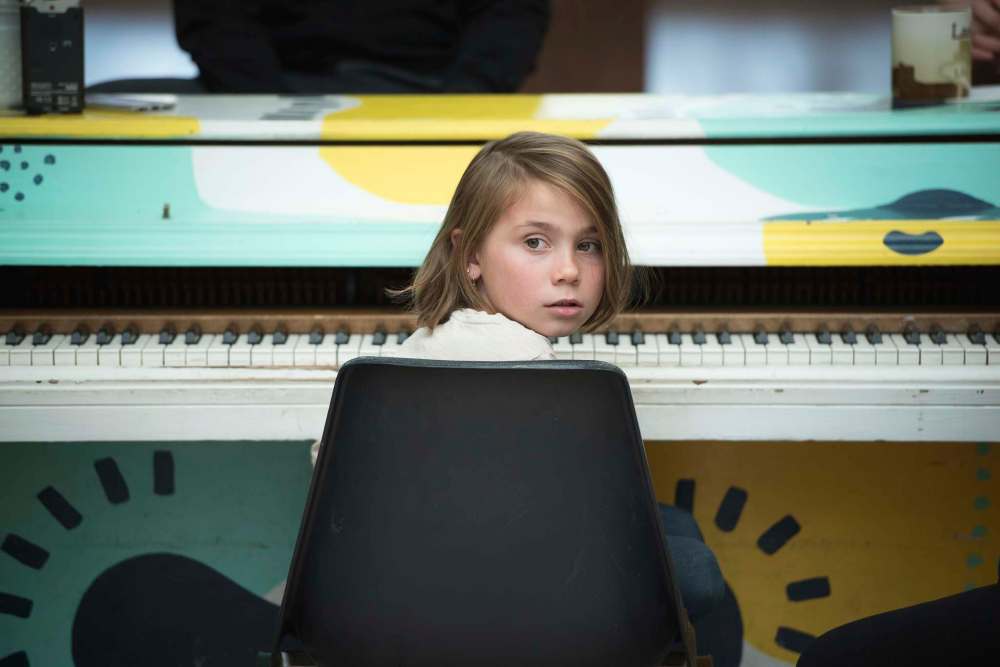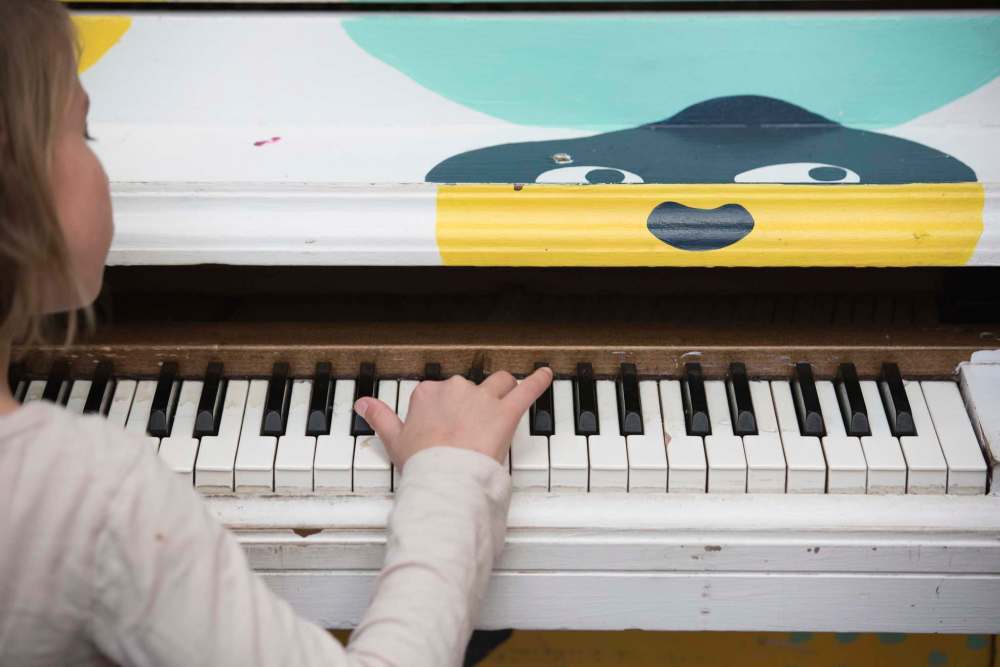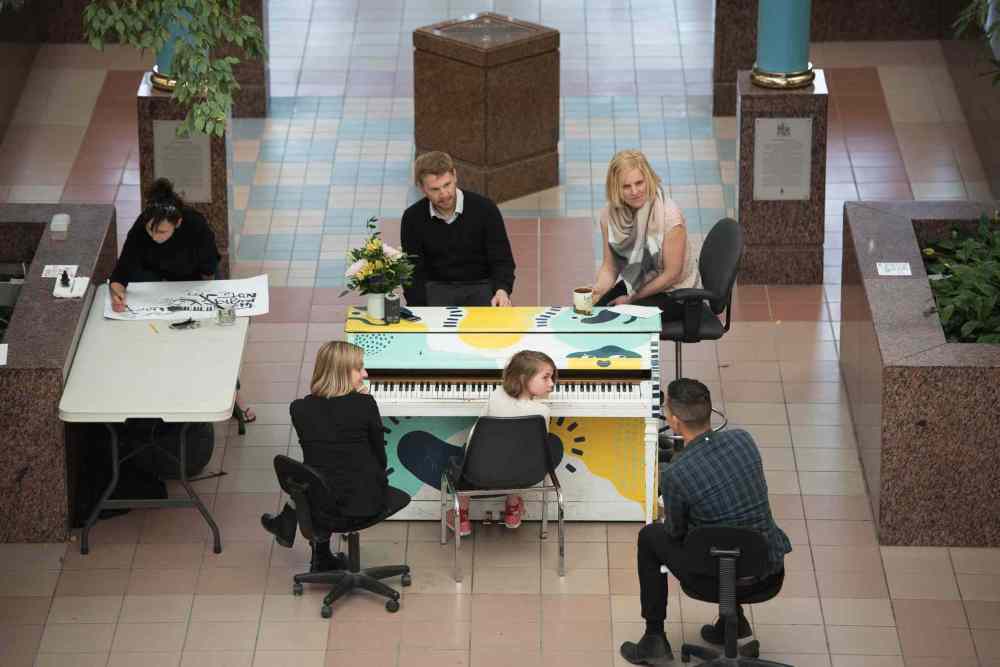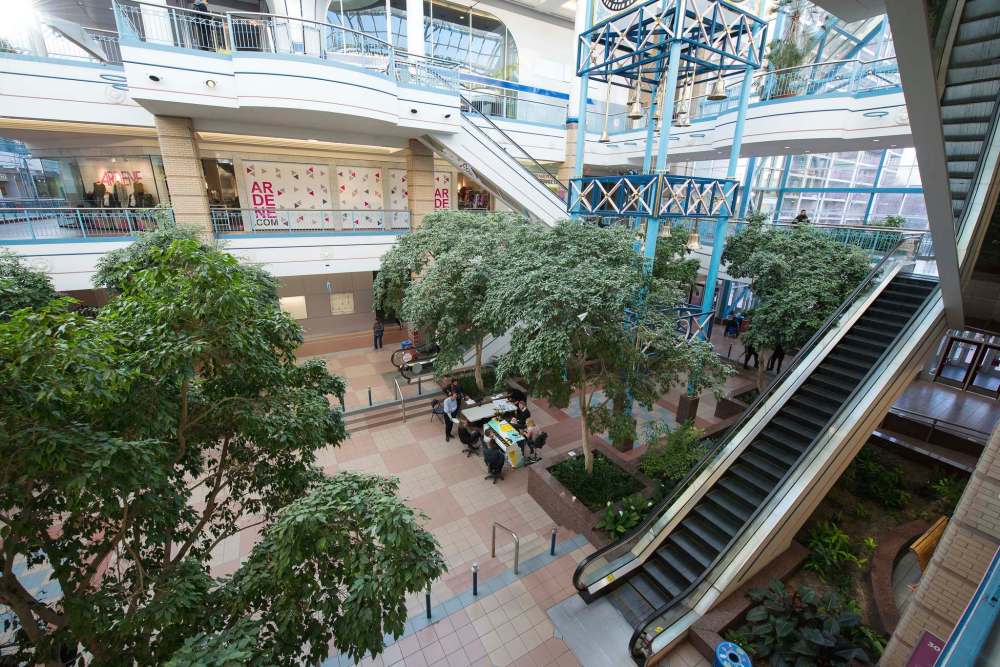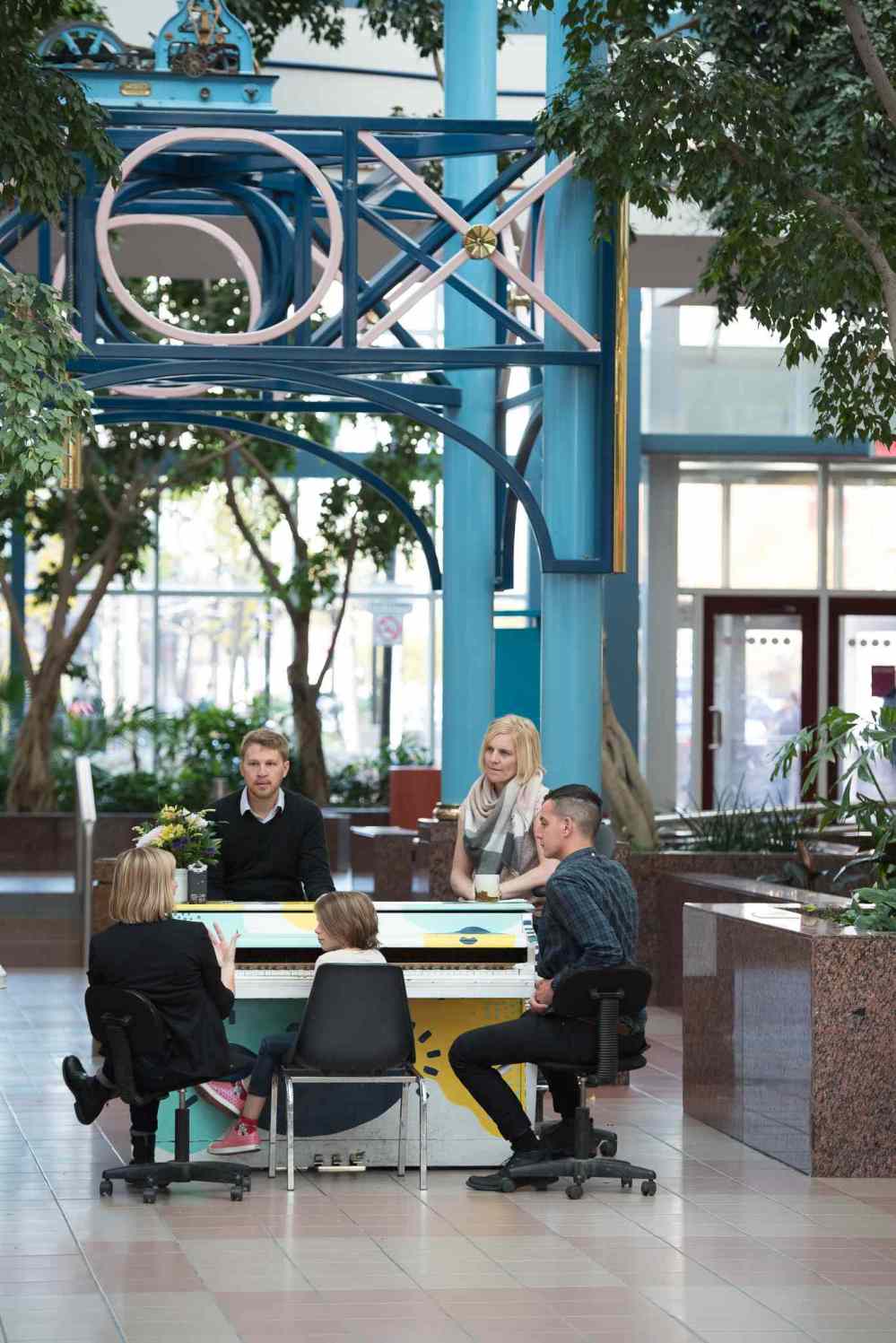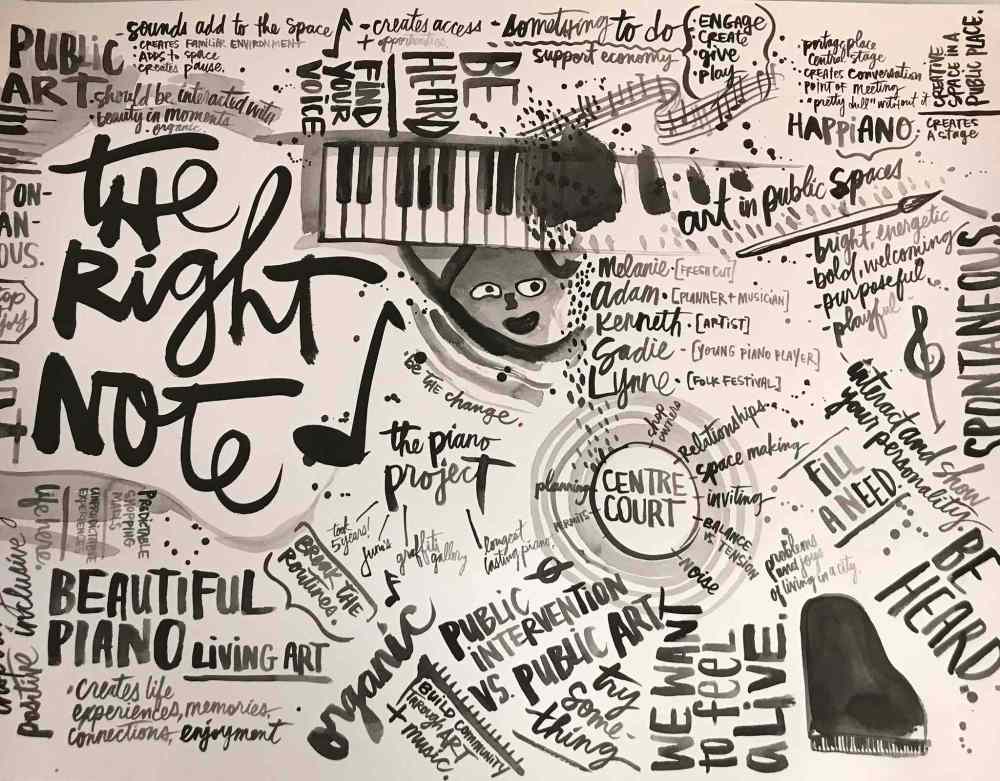Finding the right note
Piano at Portage Place addresses underserviced and overlooked civic life
Advertisement
Read this article for free:
or
Already have an account? Log in here »
To continue reading, please subscribe:
Monthly Digital Subscription
$19 $0 for the first 4 weeks*
- Enjoy unlimited reading on winnipegfreepress.com
- Read the E-Edition, our digital replica newspaper
- Access News Break, our award-winning app
- Play interactive puzzles
*No charge for 4 weeks then billed as $19 every four weeks (new subscribers and qualified returning subscribers only). Cancel anytime.
Read unlimited articles for free today:
or
Already have an account? Log in here »
Hey there, time traveller!
This article was published 17/11/2017 (2349 days ago), so information in it may no longer be current.
To celebrate the arrival of the 2014 Junos, the Downtown Winnipeg BIZ led an initiative to position pianos throughout the downtown. It was a way to promote the event but also an opportunity for people to gather, to enjoy public space and to take in public art.
The pianos, designed by Graffiti Art Programming’s youth and guided under the mentorship of artists such as Kenneth Lavallee, were unique blank canvases. The initiative, called Play Your Part, attracted thousands of visits to the downtown, and photographs of musicians performing at the pianos.
At 4 p.m. sharp, the sound of Portage Place Shopping Centre’s clock tower sounded – marking the start of a beautiful conversation. Lavallee, HTFC Planning & Design’s Adam Kroeker, Freshcut Downtown’s Melanie Bernadsky, Winnipeg Folk Festival’s Lynne Skromeda, and nine-year-old Sadie Pusiewich sounded off on the piano initiative as an example of how to add public amenities in a civic life that is often underserviced and overlooked.
Kroeker has worked on plans across Manitoba, Ontario, and the Northwest Territories to make communities healthier, happier, and more enjoyable for people of all ages. He is also active in Winnipeg’s music scene as a member of The Mariachi Ghost.
Lavallee, a Metis artist, has been a committed mentor for young artists at Graffiti Art Programming. He is no stranger to urbanity, as much of his work has been modified into life-size murals – often placed in underserved areas and vacant buildings. His current work can be seen at the Winnipeg Art Gallery’s current exhibit, Insurgence Resurgence, the institution’s largest-ever contemporary Indigenous art show, celebrating the stories and artwork of 29 artists from across Canada.
Bernadsky has owned the floral shop Freshcut Downtown since 1995 and is an avid downtown volunteer and board member of the Downtown Winnipeg BIZ. She noted throughout the conversation how she has seen a large change in how Portage Place has welcomed the community, with initiatives like Play Your Part.
“As a Portage Place business owner, I probably have the best view of the piano.”
The Winnipeg Folk Festival, one of Manitoba’s longest running festivals, has implemented several initiatives that have purposefully invaded public, urban spaces with music — having programmed places like the Cube in Old Market Square, the City Hall courtyard and the Millennium Library.
Skromeda, Folk Fest’s executive director, herself has also been a community supporter of music, arts and the environment in a variety of ways through her many years in the local film and TV industry and spending time on boards such as the West End Cultural Centre, Green Action Centre and Manitobans for the Arts, all of which promote the positive use of culture and environment.
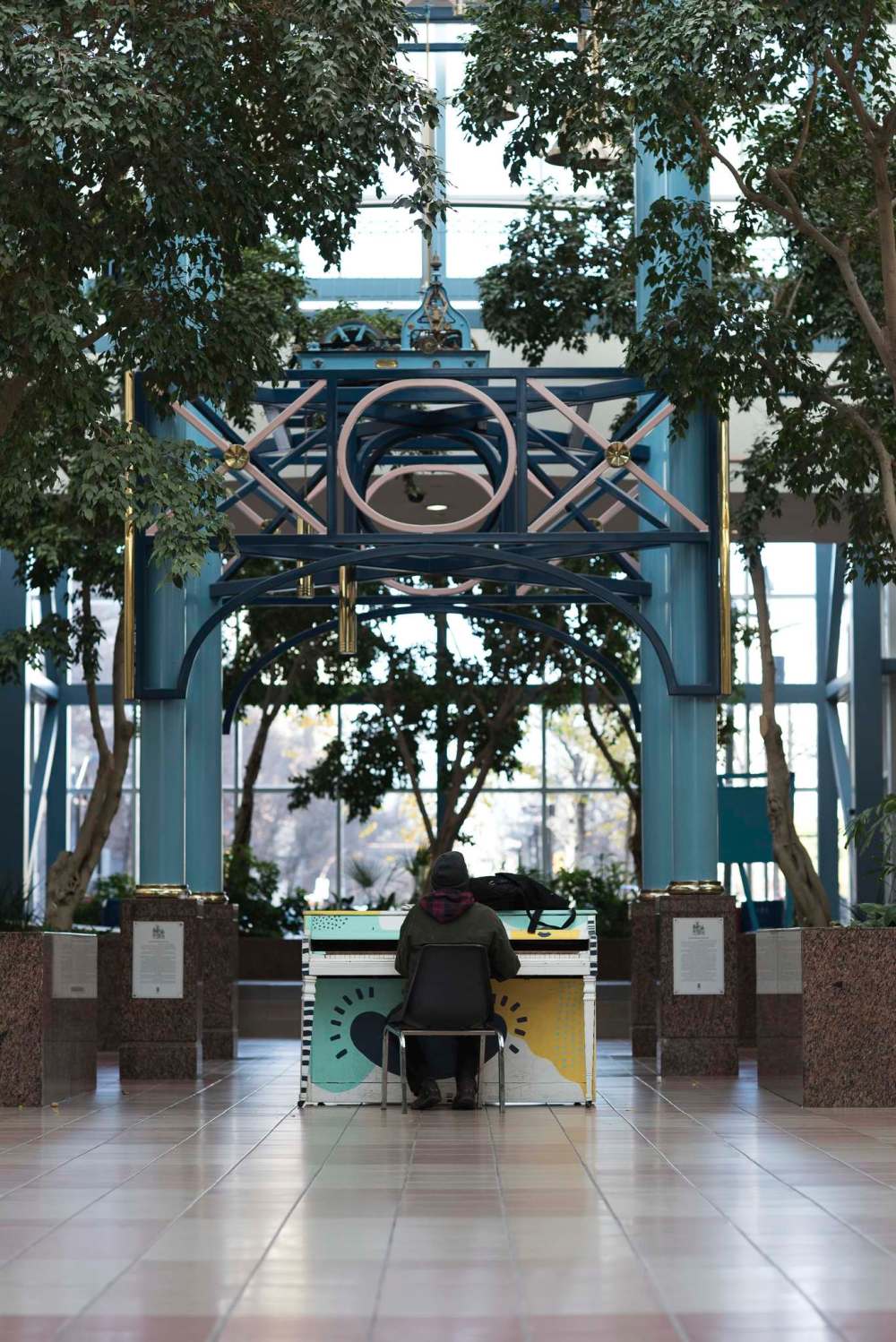
Pusiewich, a nine-year-old student at Riverbend Community School, recalled her story about how she encountered the piano for the first time: “I first discovered the piano while coming to an acting class at Portage Place. I was preparing for my piano recital at the time, so I took a chance to play most weeks coming or going from class. It just looked like something you have to go and try. And it was so fun!”
Pusiewich represents the youth for whom many planners and designers are building their cities for. As our youngest Duets participant yet, Pusiewich provided a very candid and honest opinion about how more of these pianos should be installed throughout downtown.
What resonated during the Duets conversation, as Skromeda says, was a unique opportunity to chat with people with different perspectives: “I’m a lifelong Winnipegger. I’ve seen Adam’s band play. I’ve bought Melanie’s flowers. I’ve seen Kenneth’s art. And Kal (Barteski) has worked with us before. It’s awesome to be able to sit down and have a conversation about art and public spaces, which connects so deeply to me personally and is also the whole focus of our festival and year-round initiatives.”
Once the Junos concluded, the pianos were left in their locations. Left outdoors, most of the pianos had to be retired because of wear and tear, and often vandalism. The Portage Place piano — affectionately known as Happiano — however, has kept its lustre over time.
Kroeker, Lavallee, Bernadsky, Skromeda, and Pusiewich hypothesized why the piano has retained its shape and form, and proposed other ideas in which to enhance public activity at Portage Place and throughout the city.
Why do you think this particular piano at Portage Place has not been destroyed or damaged?
Skromeda: Its placement. Where it is — it’s a central focus. People can come and see it from all directions. It’s obvious, it’s on display. People can engage with it. People can see it as a piece of art and as a piece of music.
Kroeker: Edmonton Court in Portage Place is such a great natural stage. Where else can you play in a place like this — where you have potentially hundreds of eyes watching you? It’s a concert hall that everyone has access to. In my opinion, great spaces give people a chance to perform in all sorts of ways.
Bernadsky: From a security perspective, there is natural surveillance. There are a lot of eyes on the piano. And there’s a feeling of safety in the mall when you hear the sound of the piano — you know people are around.
Lavallee: Even the design and the colours itself. I designed it that way. I thought it was going to be on the streets — so I wanted it to be visible with bright colours, so you could see it from a block away. Lately in my art, I have been trying to go big – with large murals on Main Street, big areas of colour.
I walk around downtown a lot — it’s drab, plain and boring. I knew the pianos were going out onto the street in the early spring — so it was dusty. I wanted something bold, bright, and visible.
Pusiewich: When I would play the piano, people would come up and say that the piano is beautiful and thank me for playing. Portage Place was pretty dull before the piano was here, so the pianos make people happy. There are even smiley faces all over the piano!
Syvixay: What’s interesting, for me, is how the piano is at the centre of many gatherings and demonstrations at Portage Place. It’s been interesting to see how the piano interacts with events like the Women’s March or Graffiti Art Programming’s breakdance battles — the piano becomes a rallying point.
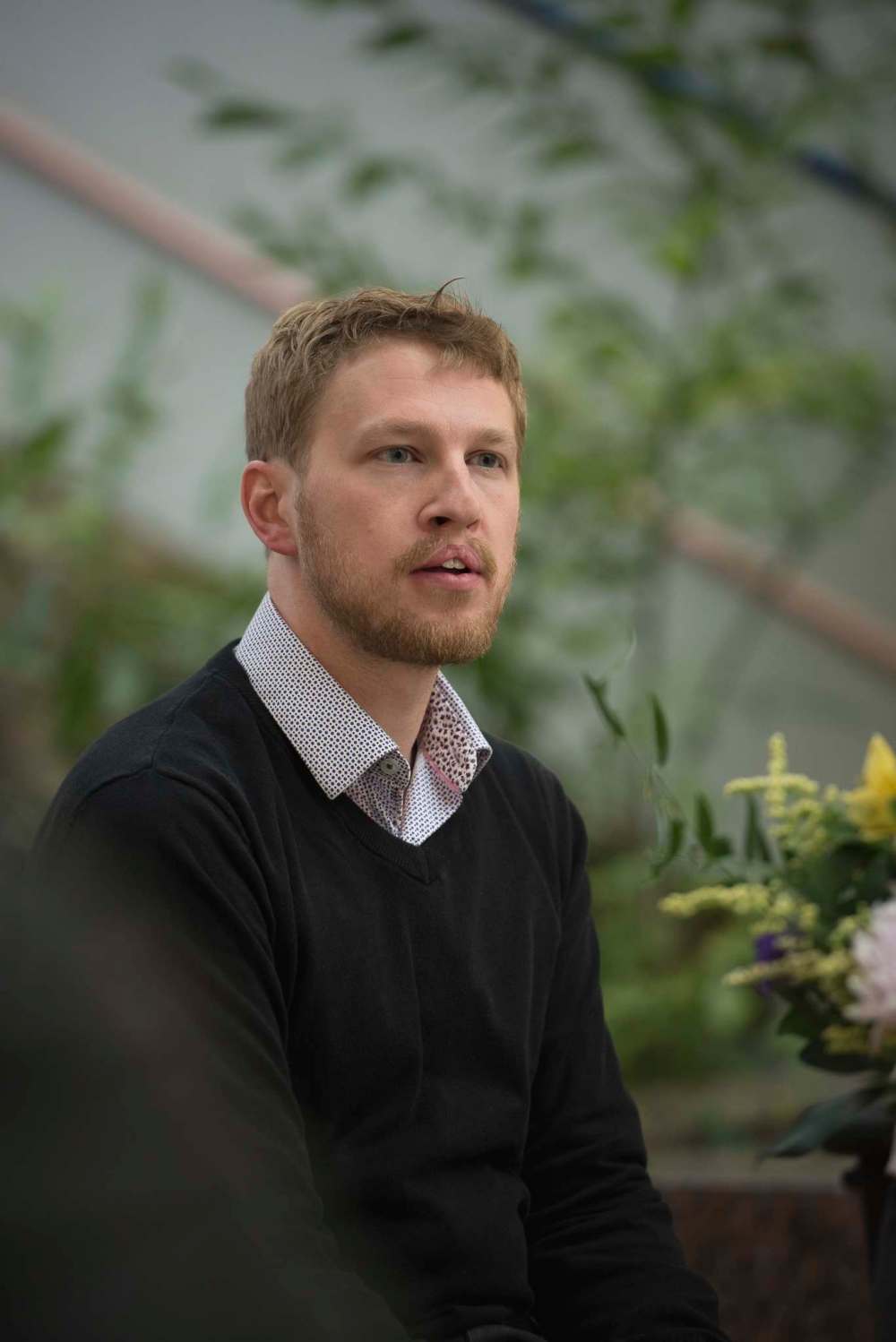
Skromeda: I was here for the Women’s March. There was a big stage set up right beside the piano. It felt like it supposed to be part of the setup.
As a business owner, Melanie, what has your interaction been with the pianos? Do you think there has been an increase in sales? What other outcomes have you noticed?
Bernadsky: In general, I support anything that is creative, positive, encouraging, and brings out all walks of life. While the mall is a business, it has become a bit of a community space too. I’m supportive of that.
Bands perform at centre court. It can get a bit loud — and it can be a challenge. So, I think there’s a gentle balance, a bit of a dance, that needs to happen between business and community initiatives.
I can’t say that people have played the piano and then purchased a bouquet of flowers. But it does bring goodwill and joy to the mall. It’s inclusive and makes people feel welcome.
Kroeker: Finding this balance is the central challenge of planning work. There are joys of living close together in a city; you can people watch. There is an exciting buzz.
But the downside is that there may be noise, congestion and other things that make urban living challenging.
Skromeda: There’s always a risk of putting something out there like the piano at Portage Place — whether it’s noise pollution, as some people may see it, or the potential for damage. But I think that most people treat it with respect, and can do interesting things with it. It allows for creativity. It allows for an opportunity to perform.
The piano is so real, and so raw. You really get to interact with an instrument. It makes you wonder — for the people who do play, do they have access to instruments elsewhere — at home? Maybe this is the place. This being here gives them an opportunity to play.
Kroeker: There need to be more opportunities in downtown Winnipeg for fun and for play. Sadie, you said Portage Place was a little dull before the piano. What more can be added?
Pusiewich: There’s a playground at The Forks. There are drums and an outdoor xylophone. These things are important because they give people a chance to interact with their personality.

Does this initiative give people a voice, a platform? Is that important in Winnipeg’s downtown?
Lavallee: Because of its location at centre court, you have a huge audience already. A lot of people who use the piano might not have Internet or Instagram to express their talents. Everyone needs some sort of outlet.
Barteski: It takes guts to perform! When you step on that piano, you earn the audience. It’s this: “Listen to me!” You can tell your story here. I think that is super cool.
Pusiewich: It’s more beautiful than my piano at home. It’s made me brave to perform at recitals.
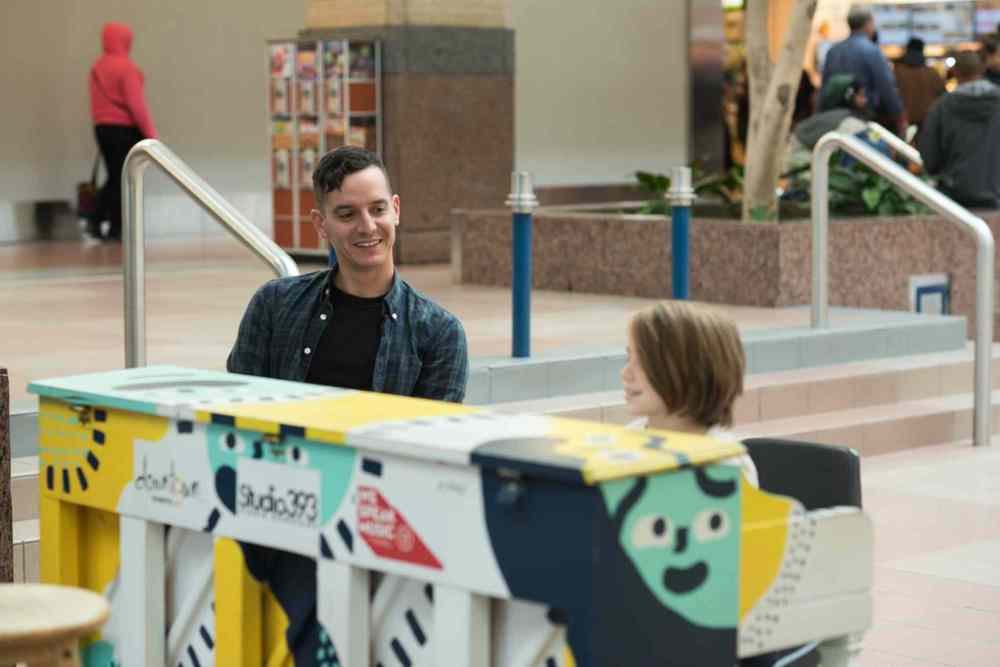
Do you see these types of public interventions as public art?
Pusiewich: Yes, because it has paintings on it. It’s in the public. We need more of them.
Lavallee: I’ve been working on a large public art project for the past year. It should go up in the next week or so, right next door at Air Canada Park. It’s a 12-foot tall steel sculpture of six blue Metis square dancers. It’s very graphic. I’ve had the model on my desk for the past six months. I’ve been waiting for permit approvals. It’s been a slow headache.
I’ve wanted to get into public art. It’s that, “Be the change you want to see.” Who doesn’t want to see beautiful things in the spaces they go to. I think public art needs to be comfortable, interactive. Some public art is fenced off, and you can’t touch it. The piano isn’t that — it invites people to come up to it. I like that type of art.
Skromeda: I also like performance as art. Public art that is visual is often permanent. A person playing the piano is fleeting. At the Winnipeg Folk Festival, we have our workshops — we put artists together who may never otherwise interact. We create these amazing moments over a period of time, and then they’re gone. I think there’s a real beauty in that — a lack of permanence.
The random performance is an amazing experience for people. The element of surprise, the serendipity, the spontaneity that is created with this type of art.
I also like the piano because of the two types of languages it brings together: music and visual art are universal languages. It doesn’t matter who you are, or where you come from — you can create a reaction. It creates life experiences that are important to us, and can be life-changing.
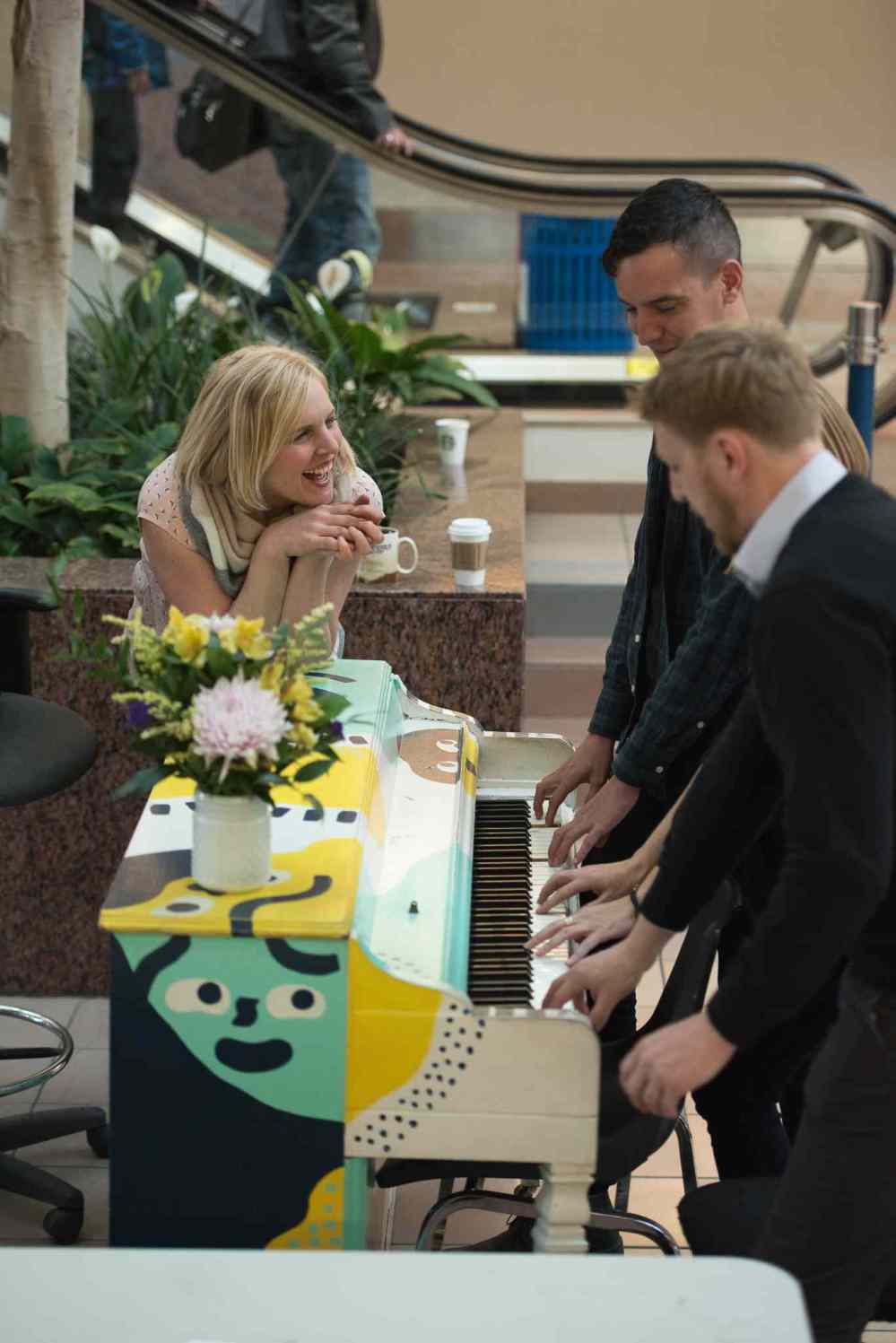
Bernadsky: I like the subtlety of the piano. People can walk by it and go about their day or choose to participate in it. It doesn’t feel invasive.
What kind of statement does adding a public initiative in a private space make?
Kroeker: Our traditional North American shopping malls are places built on the model of conformity and consistency. You find the same shops in malls across the country; it doesn’t matter if you are in Minnesota or Moose Jaw. That consistency is comforting to some consumers, but it also makes most malls boring places.
The piano at Portage Place deconstructs the essence of a mall — here, anything goes. Portage Place has become a place where things can happen outside of the norm.
Some urbanists have looked at Portage Place as a failure — but I like to think of it as a mall of the future, something where more interesting things can take place. There are now different types of activity with space in the mall, like Studio 393’s graffiti art programming. It feels like there is life here.
Bernadsky: Malls won’t completely go away. So if they are going to be here, then maybe adding the community creative piece should be pushed for.
Lavallee: At the same time, I don’t think malls can just fake it either. There’s something organic about this mall at Portage Place — people clean it, take care of it. If the piano was built with Portage Place originally, I don’t think it would have had the same impact. The community placed the piano here. It feels more authentic.
Skromeda: Architecture has changed over time. Buildings were pieces of art — they were ornate. Now we live in a society where the angles are sharper and cleaner.
I think it’s interesting that we gravitate towards putting things like the piano in these buildings to make them feel alive, more artistic. There are trees around us, there’s music in here.
All of this stuff is important to add in a private space – they are things we value.
Lavallee: This is a beautiful courtyard. The amount of light – it’s so insane. I love it.
Temporary installations often illuminate elements of city life that are ignored, missing, overlooked, disinvested, or under serviced. What does the piano initiative say about the state of Portage Place, about the city, downtown, and people? Does this initiative raise larger questions – like the values of our city and downtown? About what kind of city we want to live in? Does it propose creative, alternative paths for us to get there?
Bernadsky: If you’re bringing in that creativity, bringing in people, bringing in energy, you feel safe, and you feel part of something. While you’re here, you might pick up a coffee, and there’s some economic development.
Kroeker: This was an initiative that was meant to be temporary but now has become permanent. The piano has highlighted that there is a need to keep filling our cities with places that surprise and delight.
Skromeda: It is about building community and how music and people are part of that. The piano brings people together to share these important ideas. It gets you thinking — it’s a conversation piece and a community builder.
Pusiewich: It shows that kids want fun things to do when they come downtown and dull spaces need to be bright, colourful and interactive. Surprises in public spaces are good — they make you happy.
Lavallee: I think they make you re-evaluate the city, and give you a fresher sense. You have your routines – you drive to work the same way everyday. But if you pop up something colourful and bright like the piano – it take you out of your routine and it makes you realize that you’re part of the city, that you can have a hand in it.
